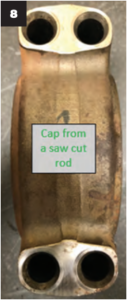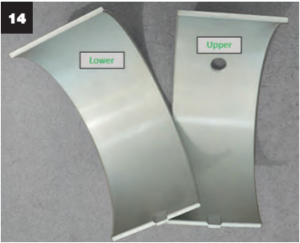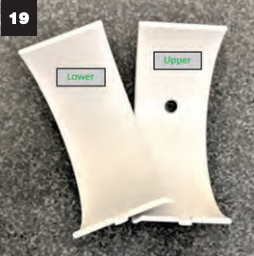



This would likely ruin your day, especially if it happens just 52 miles after an engine was rebuilt. Figures 1 and 2 above show the damage the piston and connecting rod did to the cylinder block and oil pan of this ISX Cummins engine as it quickly began to destroy itself.
Everyone makes mistakes, and sometimes it’s just one of those quick lapses in concentration that ends in a big problem. You’ve likely heard the idiom, “the devil is in the details” and the devilish detail that caused this engine to fail is in figures 3 and 4. Do you see it? Here’s a clue, this is a Cummins ISX with “saw cut” connecting rods.

The two most common connecting rod designs used today in the ISX engines have an oil passage which supplies oil from the rod bearing (big end) up to the rod bushing (small end), and are either “saw cut” or “fractured” rods. These terms describe the surfaces between the connecting rod and rod cap. (Figure 5)
“Saw cut” rods have been used for years, and the parting surfaces of the rod and cap are machined.

Earlier engines used non-drilled rods that are not 
Saw cut vs. fractured rods can also be identified by the design of the cap. The cap from a fractured rod has a hole that a saw cut cap does not. (Figures 8 and 9)

Did you get all that? Good, now back to the point of this article.
If you haven’t found that “detail” yet, figures 10 and 11 might help. At first glance it may appear the bearing was manufactured incorrectly and is missing an oil hole. However, that is not the case with these bearing shells.
Typically, the connecting rod bearing shells either have identical profiles, and can be installed in either the rod or cap, as shown in figure 12, or they have an upper and a lower shell, where the locating tabs are spaced differently, generally assuring they can only be installed in the correct position, as shown in figure 13.

The ISX saw cut connecting rod bearing shells are positional (similar to figure 13), but the detail that can get overlooked is the spacing of the locating tabs are so slightly offset they do not prevent the shells from being installed in the wrong position! (Figures 14 and 15)

Installing them incorrectly is noticeable, as compared in Figures 16 and 17, but the misalignment does allow enough clearance that the connecting rod can still be bolted in place to the crankshaft. If this happens, the engine is destined to fail.
When the shells are installed incorrectly, the edge of the bearing will wear on the fillet radius of the crankshaft, and since the lower shell (which would then be in the upper position) doesn’t have the oil supply hole in it, the connecting rod bushing (small end) and piston pin connection fails due to the lack of an oil supply.

Hopefully sharing this information and bringing this potential problem to someone’s awareness will keep this from ruining someone else’s day.
If it’s any consolation, the tabs on the newer designed fractured connecting rod are actually aligned with each other, but a secondary “notch” or tab in the corner of the shells prevents them from being installed into the rod incorrectly.

By the way, the fractured rod introduced a few torments of its own. How the rod and cap are handled, cleaned and assembled is critical. The cap and rod are serialized to identify their orientation and keep them paired together. The surfaces cannot be rubbed together or even slightly damaged. If the cap is mistakenly placed on the rod backward or on another rod, or if either are dropped/impacted on the fractured surface the rod must be replaced. Refer to the OE service bulletins for more details regarding handling and cleaning this type of connecting rod. Clearly the manufacturers figured out a solution to this devilish detail to prevent this installation problem with fractured connecting rods. However, with the saw cut rods, it’s up to you to pay attention or else the engine may pay the price.■
Steve Scott joined the service department at lPD in 1982, working with parts, service and sales for a variety of equipment, diesel, and natural gas engines. Since 2004, he has been the director of product development and technical support for lPD. For more information, email sscott@ipdparts.com.
If you’re an existing customer and already have a login, click here to find IPD quality parts.
If you would like to find an IPD distributor or become an IPD distributor, please fill out our form.